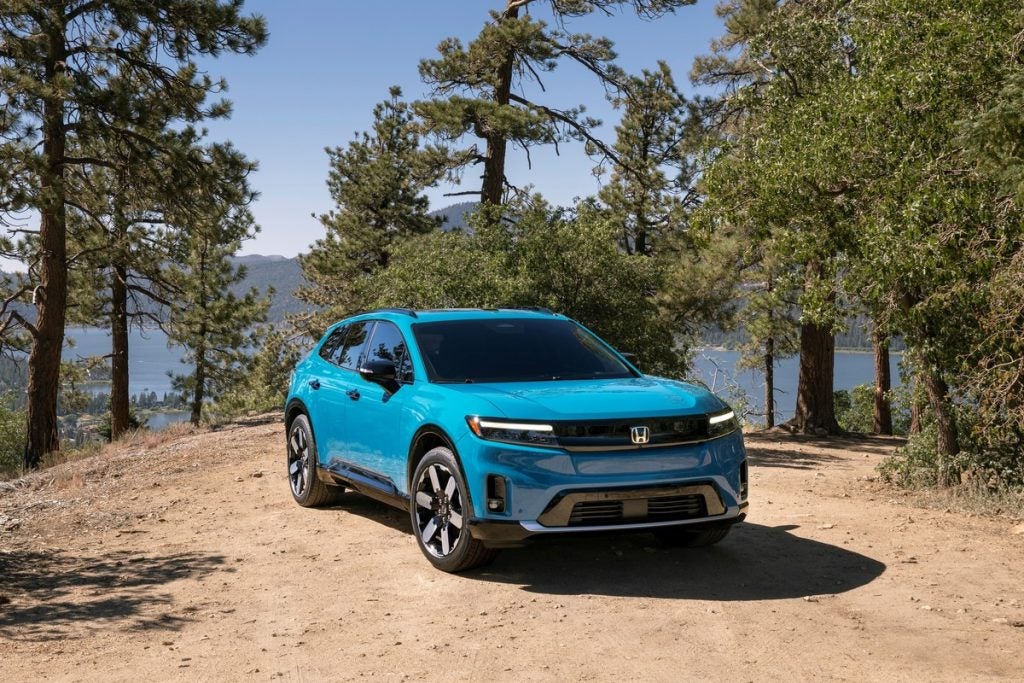
General Motors has big plans for the boutique Swedish marque that, along with Cadillac, has been earmarked by the American leviathan to become its premium brand internationally. To throw some perspective on to this ambitious plan, Saab wants to lift its sales from a painfully modest 133,000 last year to 250,000 in the medium term. Since it bought 50% of Saab in 1990 (picking up the other half share last year), the US giant has done little more than oversee replacement models. It has hardly been adventurous. Like the dog that chased a car, it didn’t appear to quite know what to do with it when it caught it.
 |
Saab’s impressive 9-5 may be joined by new models soon, following a heavy GM investment |
GM now putting heft behind Saab
But now GM is putting some heft behind Saab – this includes new production facilities, a hip new head of design, marketing funding and a brace of new models that will take Saab into hitherto uncharted territories. It’s a $US6 billion investment to build a new product portfolio. A curious sidebar to the GM thrust is that it parallels Ford’s paternal ambitions for that other Swedish carmaker, Volvo. Of course Ford, after a sluggish start, has already had some significant success in reshaping Jaguar internationally, providing the resources and money to give the British heritage badge a resounding cut and polish.
But Ford’s Detroit hierarchy has been clever with its portfolio of prestige marques (Jaguar, Volvo, Land Rover, Lincoln, Aston Martin), putting them into a leather-and-walnut lined basket called Premier Automotive Group in the charge of one Dr Wolfgang Reitzle, a gent with a well-used passport, some hot previous form at BMW and a mindset that extends beyond a corner of Michigan. GM may have a similar plan to consolidate its blue chip brands under the eye of someone who appreciates global marketing in the toughest of all segments. But we have seen no sign of it yet.
So as Saab sets off in search of an army of well-heeled customers across Mother Earth, GM could be viewed as both potential saviour and the likely villain here. Its war chest, technological clout, and vast array of platforms can only benefit Saab.
How well do you really know your competitors?
Access the most comprehensive Company Profiles on the market, powered by GlobalData. Save hours of research. Gain competitive edge.

Thank you!
Your download email will arrive shortly
Not ready to buy yet? Download a free sample
We are confident about the unique quality of our Company Profiles. However, we want you to make the most beneficial decision for your business, so we offer a free sample that you can download by submitting the below form
By GlobalData |
At the moment Saab has just two model lines, the 9-3 (above) and the 9-5 |
An aspirational marque appealing to ‘post-modern executives’
But the inwardly looking, unwieldy Detroit giant has shown a questionable understanding of global tastes and a sad history of dealing with upmarket brands. Since the 1960s, it has managed to turn the once-proud and revered Cadillac into an international joke outside a shrinking bunch of aged Mid-West U.S. customers. While GM has always had difficulty understanding how it should manage jewels, Saab insists it will be allowed to retain its inherent character as it evolves nicely from a cute Scandinavian brand with a quirky reputation into a highly desirable aspirational marque appealing to what the marketing troops call ‘post-modern exclusives’ – we’re told this group is more daring than Benz buyers and not as enthusiastic about status symbols as the BMW crowd. There is much work to be done. At the moment Saab has just two model lines – the rather ordinary 9-3, and the impressive 9-5.
 |
It could be said that GM doesn’t understand how to handle its premium brands – will it succeed with Saab? |
Product-driven growth plans
The ambitious push to double its sales in a sector of ever-increasing competitive intensity will come on the back of a catalogue of new products hitting segments in which Saab has never previously competed. “Our growth plans are product driven – the marketing aspect is just icing on the cake,” Saab global brand manager Patrik Riese declared. He says Saab will be positioning itself as an alternative to BMW but all the time moving towards what he calls “post-modern values”. “We want to offer sporty, multi-dynamic cars for premium buyers,” adds Riese.
There will be some work too on repositioning the brand. Often described as quirky, cold and cerebral, Saab would prefer to be perceived as being bold, versatile, individual and warm. The first clear hint of its future model path will come at the Frankfurt show later this year when it will unveil its first concept car in eons, a coupe-like creation described intriguingly by insiders as a “Shooting Brake”.
It utilises the modular GM Epsilon II platform upon which the next-generation 9-3 will also be built when introduced next year (incidentally with an estate and all-wheel-drive model in that range for the first time). “The concept car we will reveal at Frankfurt will be a symbol for the brand,” said Saab design chief Michael Mauer, who brings to the marque an impressive CV from Mercedes-Benz (where he was involved with the Smart car, A-class, SL and SLK).
The Shooting Brake promises to stir the same level of interest that made the Porsche Boxster and Audi TT big hits at past shows. It will be Saab’s first concept model since the EV-1 in 1985 and its first two-seater sporty since the slow-selling Sonett III of the early 1970s. Expect it to be turbocharged. This concept-for-production is one of no fewer than nine new products easing along a hitherto seriously underused pipeline at Saab. The potential volume-boosters include a crossover all-wheel drive, a smaller car dubbed 9-2 and a four-wheel-drive lifestyle vehicle pitched at the Mercedes-Benz M-class and BMW X5. The appearance of a serious chest-beating luxury off-road concept at the 2002 Detroit show shouldn’t be ruled out. Of course, Mauer’s influence will take some time to drift into production cars. He’s only been in Sweden for a year.
 |
Saab design chief Michael Mauer |
GM platforms and powertrain will help
Seriously limited by its modest resources and lack of cash, Saab is now getting access to the vast selection of platforms and powertrains available across the GM empire (including affiliates). Expect to see a flow of new products emerging at the rate of at least one per year. Saab’s dilemma is that top-drawer customers will not pay premium prices for stylish sheet metal disguising undistinguished technology selected from GM’s parts bin. Importantly, Saab appears to understand the challenge and says it is confident that any borrowed technology can be refined to meet the higher expectations of prestige-brand customers.
Working with Fiat
Some new models are being developed in conjunction with Fiat, with which GM has formed a cosy alliance (each owns a share of the other). The venture is all about splitting development costs that can run as high as $US2 billion. Engineers at a new technical centre near Gothenburg in Sweden are developing a versatile premium floor pan that could use common parts, such as front and rear suspensions, electronics, engines and transmissions. The venture will uncork a new Saab 9-5, (and an Alfa-Romeo and Lancia) and there will be an all-wheel-drive variant, probably around 2004. GM hasn’t confirmed if the new platform will also be used for a Cadillac.
While many hidden components will be shared by the three brands, each will end up with a very personalised car, with distinct styling and performance. Fiat and Saab have collaborated before, developing the Saab 9000, Lancia Thema, Fiat Croma and Alfa Romeo 164 in the mid-1980s. One potential benefit is that Subaru, which is GM’s nominated developer of all-wheel-drive technology, may be involved with Saab’s impending AWD products.
 |
GM want to position Saab as a serious alternative to BMW and Mercedes |
The new models should help Saab move away from its traditional role as a Nordic curio.
As yet, we haven’t heard discussion of a coming “hero” car, considered an imperative for premium brands. It will also need to consider more lavish interiors, the brainy transmissions, the battery of driver aids and maybe even a hi-tech V8 such as those offered by Lexus, Mercedes-Benz and BMW.
GM’s nominal turbocharging development source internationally, Saab will continue to employ both low and high-pressure turbocharged engines for its products, although it hasn’t ruled out a sophisticated V8 and other naturally aspirated powerplants for the future. To help with its image and positioning, Saab also desperately needs a ‘ballsy’ range to rival the much-admired BMW M cars and AMG Mercs. Its other major challenge is a worldwide issue with resale values.
Saab will ‘never do retro design’
Much depends on designer Mauer’s vision. He has been loaded with the responsibility to give future Saabs the contemporary, elegant styling to tackle the present high flyers, without alienating the loyalists or hurting its existing core brand values and heritage. Though it places much on its aircraft heritage and that identifiable Saab ‘look’, don’t expect Saab models of tomorrow to arrive with a retro theme. “Saab will never do retro design – it is a less creative and easier solution,” Mauer said. Judging by his work with Mercedes-Benz, Mauer is no conservative; more an adventurous classicist in design, perhaps.
It seems highly likely that Mauer-influenced Saabs will have little of the orthopaedic boot look of the past three decades. Mauer came clean with his ingredients for good design, using a modified version of the real estate credo. Design has three elements, he said: “First: proportions, second: proportions and third: proportions.”
To view related research reports, please follow the links below:- Automotive regional report: North America The world’s car manufacturers: A financial and operating review |







